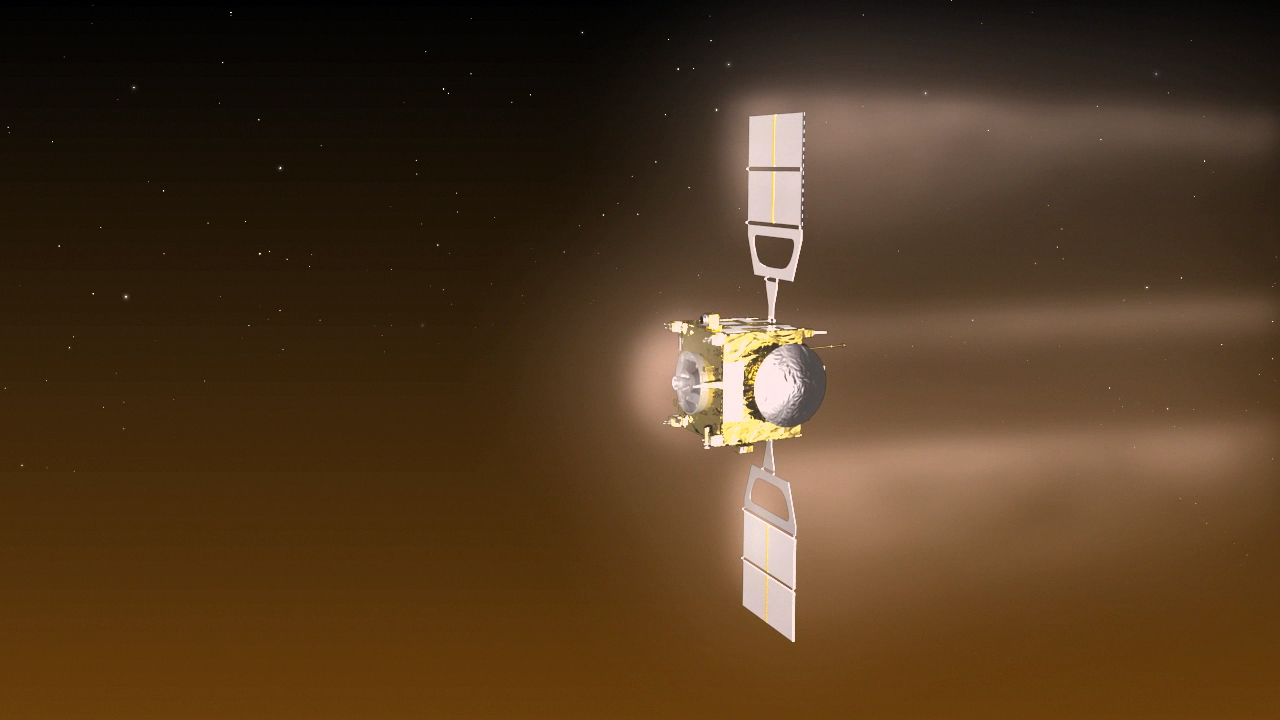
After more than eight years of extensive study of our nearest planetary neighbor, the mission of the European Space Agency’s Venus Express spacecraft was declared officially over in December 2014, following the depletion of its onboard fuel which allowed it to maintain the orbital altitude needed for scientific observations and dooming it to an eventual fiery demise into Venus’ infernal atmosphere. Now the spacecraft seems to have finally met its fate, as indicated by the last carrier signal that it managed to transmit to Earth earlier this month before going radio silent, while writing the last chapter for its highly successful mission of exploration and discovery around the second planet from the Sun.
Having almost the same size and density as Earth, Venus had been originally seen as an inhabited, hot tropical version of our Home Planet prior to the dawn of the space age. The many dozens of robotic missions that had visited it during the past 50 years have instead revealed a world that is more inhospitable than a house kitchen oven. Replete with a blistering hot surface temperature that exceeds 460 degrees Celsius and a pressure almost 93 times that of Earth’s, enveloped by a crashing atmosphere that is mostly composed of carbon dioxide and covered with clouds consisting of highly corrosive sulfuric acid, Venus seems anything but Earth’s sister planet. Despite these extreme conditions, our planetary sibling turned to be anything but an uninteresting world, as revealed by the fascinating results that were beamed back by the Venus Express spacecraft. Based on the design of the equally successful Mars Express orbiter, which continues to study the planet Mars since arriving there in 2003, Venus Express was ESA’s first-ever mission to orbit Earth’s “twisted sister,” conceived as part of the agency’s Cosmic Vision science program. Designed and built by EADS Austrium, the 1,276-kg spacecraft was launched in November 2005 on top of a Soyuz-FG/Fregat rocket from the Baikonur Cosmodrome in Kazakhstan and was eventually settled into a 24-hour highly elliptical 66,000 by 250 km polar orbit around Venus in April 2006, signalling the start of its primary science mission.
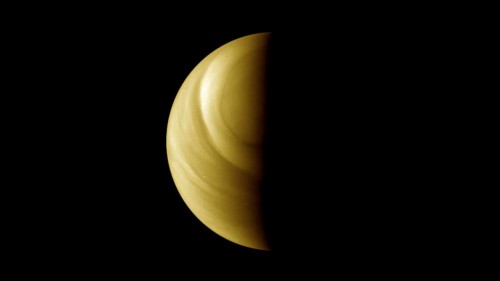
Since that time, the spacecraft made a series of exciting and unexpected discoveries that have led to many important insights regarding the atmospheric and surface conditions of our neighboring planet. One of the more unexpected results to come out of the mission was surprising evidence suggesting that Venus’ rotation may have slowed down significantly over a period of 20 years, since NASA’s Magellan mission explored the planet during the early 1990s. Launched in May 1989, the Magellan spacecraft was the first to make a high-resolution radar mapping of 98 percent of Venus’ surface, penetrating its obscuring thick cloud decks and providing us with unprecedented views of the planet’s topography for the first time. In addition to these radar views, Magellan also collected high-resolution gravity data during its four-year mission, which helped scientists to clock the planet’s slow rotation at being equal to 243,0185 Earth days. After arriving in 2006, the Venus Express spacecraft started studying the dynamic interactions between the planet’s atmosphere and surface, with its onboard Visible and Infrared Thermal Imaging Spectrometer, or VIRTIS, an imaging spectrometer sensitive to ultra-violet, visible, and infrared wavelengths between 0.25 and 5 µm. The results showed that some surface features were displaced by as much as 20 km from where they should have been, compared with the radar data from Magellan. The only explanation accounting for the discrepancies between the two spacecrafts’ different data sets was that the planet’s rotation had slowed down by approximately 6.5 minutes since the early 1990s. “When the two maps did not align, I first thought there was a mistake in my calculations as Magellan measured the value very accurately, but we have checked every possible error we could think of,” says Nils Müller, a planetary scientist at the DLR German Aerospace Centre’s Institute of Planetary Research in Berlin.
Despite the seemingly slowing down of Venus’ rotational period, the wind speeds high in the planet’s atmosphere on the other hand have been getting faster. Previous missions had already established that, despite its great density, the atmosphere of Venus is in a state of “super-rotation,” circling the planet every few days, with winds blowing as high as 300 km per hour. By studying the high-resolution images of Venus’ atmosphere that were returned by Venus Express, scientists were able to track the movements of various features on the planet’s cloud tops which clearly showed that wind speeds were steadily accelerating to 400 km/h over the course of the spacecraft’s mission. “This is an enormous increase in the already high wind speeds known in the atmosphere,” says Dr. Igor Khatuntsev, a planetary scientist at the Space Research Institute in Moscow. “Such a large variation has never before been observed on Venus, and we do not yet understand why this occurred.” Furthermore, a series of detailed measurements with the spacecraft’s Venus Radio Science instrument, or VeRa, revealed the presence of atmospheric “gravity waves” whose existence had been hinted by past observations. These atmospheric waves appear as narrow, straight features that propagate through the Venusian cloud tops, resembling the ripples and currents on a river’s surface when water flows over an obstacle like a submerged rock. It is thought that these gravity waves on Venus behave in a similar manner, as they flow over the planet’s largest mountaintops like Maxwell Montes, an 11-km high mountain which is located at Ishtar Terra, a continent-sized highland region near the north pole, indicating that the atmospheric circulation on Venus is at least partly affected by the planet’s topography. “We believe that these waves are at least partly associated with atmospheric flow over Ishtar Terra, an upland region which includes the highest mountains on Venus,” says Dr. Silvia Tellmann, Vice-Director of the Department of Planetary Research at the Rheinisches Institut für Umweltforschung in Cologne, Germany, and Co-Investigator for the VeRa instrument onboard Venus Express. “We don’t yet fully understand how such topographic forcing can extend to high levels, but it seems likely to be one of the key processes for the generation of gravity waves at high northern latitudes on Venus. The waves may form when a stable air flow passes over the mountains.”
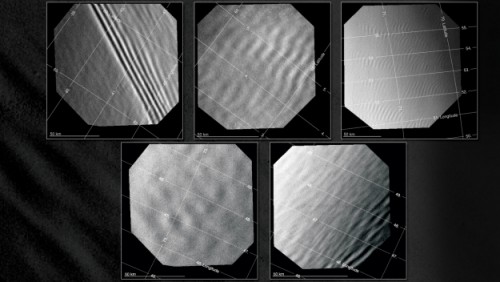
Venus Express also studied the planet’s ionosphere during solar minimum in 2010, a period in the Sun’s 11-year cycle which is characterized by a diminished activity from our home star. The spacecraft revealed that even at periods of reduced solar wind outflow, the latter can nevertheless greatly affect planetary atmospheres, by observing that the ionosphere of Venus was shaped like a comet’s tail from the pressure of the solar wind, transported from the day side to the night side of the planet and extended for thousands of kilometers into space. Other atmospheric observations included the detection of a tenuous ozone layer at an altitude between 90 and 120 km above the surface of Venus, the discovery of an ultra-cold atmospheric layer at an altitude of 125 km along the planet’s terminator (the line between the daytime and nighttime side) with a mean temperature of -175 degrees Celsius where conditions might allow atmospheric carbon dioxide to freeze out as snow, as well as the detection of periodic surges in the amount of atmospheric sulfur dioxide. The latter in particular might be linked to present volcanic activity at the surface of Venus. More specifically, the Spectroscopy for Investigation of Characteristics of the Atmosphere of Venus instrument, or SPICAV, onboard Venus Express, measured elevated levels of atmospheric sulphur dioxide very early in its mission, between 2006 and 2007, which steadily decreased in subsequent years, akin to a series of similar measurements which had also been conducted by NASA’s Pioneer Venus mission during the 1980s.
Nevertheless, the presence of sulfur dioxide alone isn’t a conclusive evidence for the existence of present active volcanoes on Venus. It could well be that the elevated levels measured by both Pioneer Venus and Venus Express were just the result of atmospheric convection of hot air rising from the lower toward the upper atmosphere, carrying sulfur dioxide along. Yet the Visible and Infrared Thermal Imaging Spectrometer (VIRTIS) and the Venus Monitoring Camera (VMC) onboard Venus Express mapped the planet at near-infrared wavelengths of around 1 micron where the atmosphere is largely transparent, allowing scientists to detect small-scale variations of surface temperature and chemical composition. These observations helped to reveal the presence of a total of nine hot spots which had a temperature that was hundreds of degrees higher compared to that of the surrounding terrain. Three of these hot spots in particular were found to be adjacent to known volcanic mountains on Venus, indicating that these sites had experienced volcanic eruptions as recently as a few thousand years ago. Could all these indirect evidence point toward a Venus that is volcanically active today? “An explosive volcanic eruption, rather like a more powerful version of the 1991 Mt. Pinatubo eruption on Earth, could act like a piston, blasting a column of gas up to [observed] levels,” comments Jean-Loup Bertaux, Principal Investigator for the SPICAV instrument onboard Venus Express. “This extra convection could carry SO2 above the clouds and temporarily increase its concentration.”
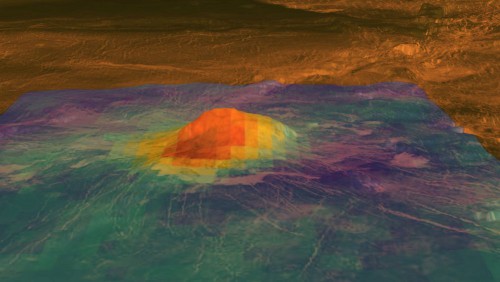
Perhaps one of the most interesting results to come from the mission, from an astrobiological point of view, was the confirmation of the huge amounts of hydrogen escaping the planet’s atmosphere, which were found to be roughly twice that of oxygen, indicating a time in the past when Venus might have been much more habitable than it is today. Because Venus lacks an internal magnetic field, the solar wind coming from the Sun penetrates deep into the planet’s atmosphere, continuously stripping it from elements like hydrogen, helium, and oxygen. The rate of hydrogen loss measured by the Analyser of Space Plasma and Energetic Atoms instrument, or ASPERA, onboard Venus Express indicates that far larger quantities of the light element existed in the planet’s atmosphere during the distant past, which combined with the oxygen that was also present could have led to the formation of huge amounts of liquid water on the surface, transforming the early Venus into a possibly habitable world. Past measurements made with NASA’s Pioneer-Venus mission in the 1970s seem to support this hypothesis, by showing that the ratio of deuterium to hydrogen on the atmosphere of Venus is more than 150 times greater than anywhere else in the Solar System, leading many scientists to speculate that the planet could have been covered by vast oceans of liquid water early in its history, which was subsequently lost into space through continuous atmospheric loss.
Despite Venus’ present unforgiving surface conditions, scientists do not exclude the (remote) possibility for the existence of simple, microbial life at the planet’s cloud tops approximately 50 km above the ground, where conditions are surprisingly life-friendly, with the atmospheric pressure being approximately 1 bar at that altitude and the temperature averaging at approximately 70 degrees Celsius. “Venus’ atmosphere has several trace gasses [at that altitude] which are not in chemical equilibrium,” writes Geoffrey Landis, a scientist at NASA’s Glenn Research Center at Cleveland, Ohio, in his study Astrobiology: The Case for Venus. “The Venera missions and the Pioneer Venus and Magellan probes found that carbon monoxide is scarce in the planet’s atmosphere, although solar radiation and lightning should produce it abundantly from carbon dioxide. Hydrogen sulfide and sulfur dioxide, two gases which react with each other and thus should not be found together, are also both present, indicating some process (possibly biological?) is producing them. Finally, although carbonyl sulfide is difficult to produce inorganically, it is present in the Venusian atmosphere. On Earth, this gas would be considered an unambiguous indicator of biological activity. While none of these chemical combinations are in themselves an unambiguous sign of life, it is interesting enough to warrant a more careful look at the atmospheric chemistry.”
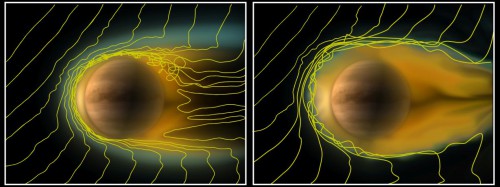
The important findings that came from the Venus Express spacecraft, regarding our nearest planetary neighbor, helped to justifiably cement its reputation as one of the most historic robotic missions in the annals of planetary exploration; however, the time for its finale was fast approaching. As detailed in a previous AmericaSpace article, following the completion of its nominal science operations in May 2014, Venus Express took a new role as a robotic daredevil, in order to begin an extensive aerobraking campaign which saw the spacecraft gradually diving deep into the atmosphere of Venus while getting as low as 129 km above the planet’s surface and returning valuable science and engineering data to ground controllers back on Earth along the way. “This provided an excellent way to study the overall density profile and small-scale density variations during each dip into the atmosphere,” says Håkan Svedhem, ESA Project Scientist for Venus Express. “During the campaign, atmospheric density was sampled 55 times and more than 30 atmospheric profiles were gathered. To our surprise, the atmosphere appeared to be more variable than previously thought for this altitude, both from day-to-day and during each individual pericentre passage.”
Disproving the concerns of the mission’s science team that it might not survive the process, the spacecraft conducted the aerobraking campaign successfully in July while remaining in one piece, after which it executed a series of 15 orbit correction maneuvers which eventually allowed it to raise its orbit one more time, to a perigee of 460 km. Having very nearly depleted its onboard fuel in the process, Venus Express was left to continue with its science observations for as long as possible, before the drag of the Venusian atmosphere would send it to its fiery doom.
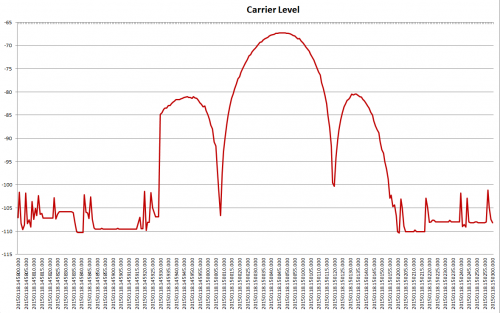
The countdown for the latter began in late November, when ground controllers lost almost all contact with Venus Express, due to the lack of the onboard propellant needed for the spacecraft to properly point its high-gain antenna toward Earth in order to receive and transmit any new commands. Nevertheless, the mission’s science team was able to still monitor for several days the weak X-band radio carrier waves that were transmitted by Venus Express’ onboard communications system, before they began to fade as well. “On New Year’s day, we saw a weak but detectable signal level and could lock onto it for most of the almost-5-hour tracking pass using the Cebreros deep-space tracking station,” recounted Rick Blake, an operations engineer for Venus Express at the European Space Operations Centre in Darmstadt, Germany. “But on 7 January, we only got carrier lock on a more weakened signal for just five percent of the pass.” Despite a slight improvement on the detection of the carrier signal in the days that followed, Venus Express eventually gave one final shout before falling silent forever. “Around 15:00 UTC on Sunday, 18 January, there was a massive spike in the carrier signal level (over 30 db!),” wrote Blake in his final update for the mission at ESA’s rocket science blog on 23 January. “This spike only lasted for a minute or so, but looks to be consistent with the spacecraft’s High Gain Antenna actually pointing at the Earth properly for a short amount of time – possibly that was Venus Express in ‘Earth pointing’ properly one last time. … There was no sign of the VEX carrier radio signal again today – just a few spurious/transitory lock indications probably on the background noise. As of today, the last detection of an intermittent carrier signal was on Monday, 19 January.”
Even though its mission is over, Venus Express leaves behind a great legacy of exploration and discovery, leading to a deeper understanding of our closest planetary neighbor and paving the way for all the future missions to Earth’s “twisted sister.” “Venus Express was an important element of the scientific programme of ESA and, even though mission operations are ending, the planetary science community worldwide will continue to benefit from more than eight years of Venus Express data and major discoveries which foster the knowledge of terrestrial planets and their evolution,” says Alvaro Giménez, ESA’s Director of Science and Robotic Exploration and Head of the European Space Astronomy Centre in Madrid, Spain.
Our next opportunity to study Venus may come by the end of this year, when the Akatsuki spacecraft, which was launched by the Japan Aerospace Exploration Agency in May 2010, will make a second attempt to enter into a high orbit around the planet following an unsuccessful first attempt in late 2010 due to a shorter than planned orbital insertion engine burn. If all goes well, the end of 2015 will see the beginning of a new chapter in the exploration of our mysterious planetary neighbor, which, despite its hellish nature, is a largely fascinating and interesting world.
Video Credit: Thomas Lucas Productions Inc./SpaceRip
Below are more images from the Venus Express spacecraft:
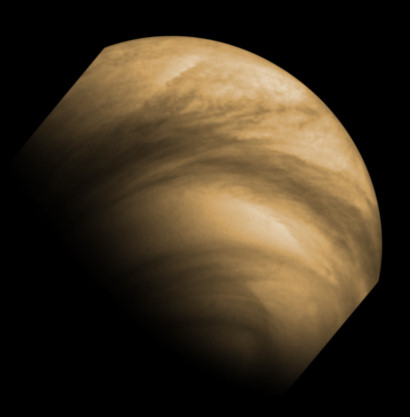
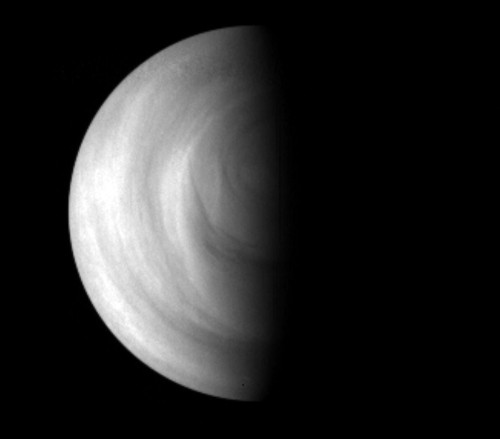
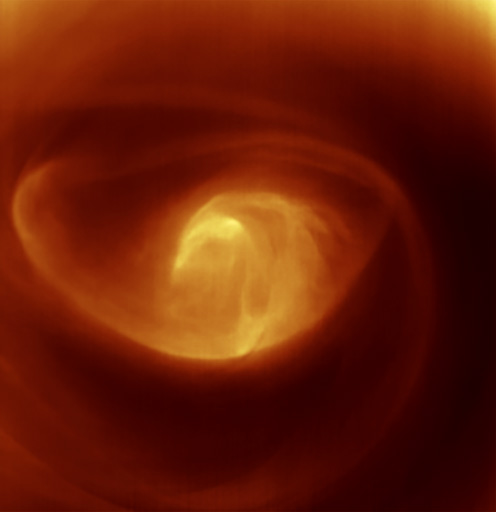
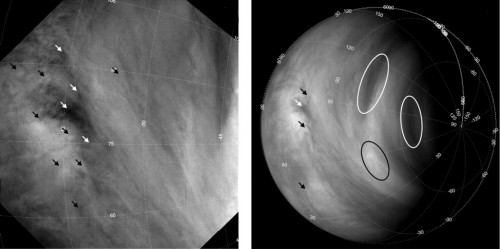
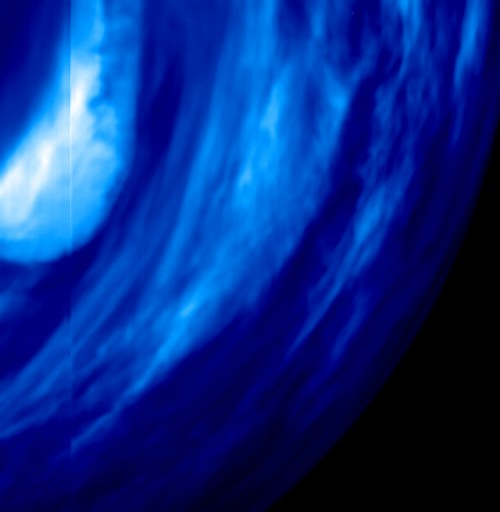

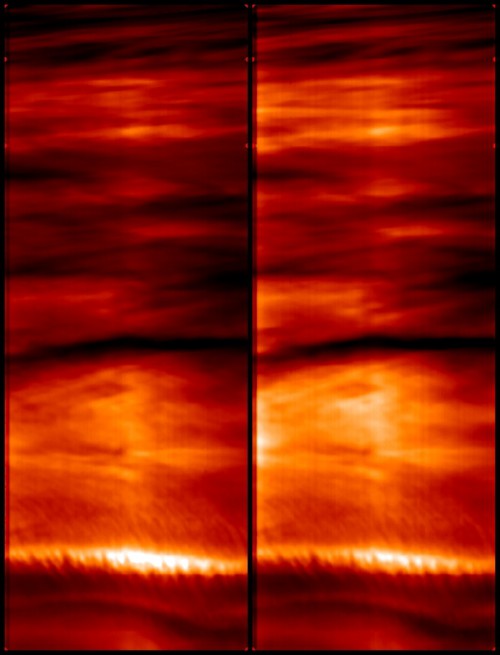

Want to keep up-to-date with all things space? Be sure to “Like” AmericaSpace on Facebook and follow us on Twitter: @AmericaSpace




Another excellent article, Leonidas. I believe we should devote additional missions to Venus, including landers. The planet’s composition and characteristics provide excellent comparative data in understanding our entire solar system. We are in the process of developing an “encyclopedia” of our planetary neighborhood and we must continue to explore.
Thank you Tom! Indeed you are so correct, planetary exploration should include every planet and moon in the Solar System. I have never subscribed to the mindset that certain planets are “boring” and “uninteresting”. As space exploration has proven time and again, spectacular and unexpected discoveries always await us in every corner of the Cosmos if we just devote the time and resources! Discoveries that can really change our worldviews about the Universe and lead to important paradigm shifts. As you have often commented, Let’s Go!